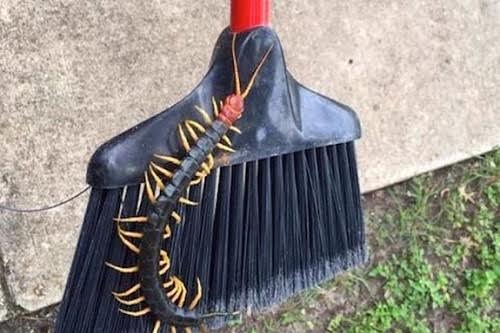The United States fluttered because of the giant red-headed centipede
The wildlife agency of Texas and the United States last week posted a giant red-headed centipede in the public.
The giant red-headed centipede made the Americans flutter
Live Science reported on July 10 that many people were frightened by the giant centipede's image, with up to 20 pairs of yellow legs and a red head.

The giant TPWD red centipede posted online.(Photo: Live Science)
Ben Hutchins, a vertebrate biologist of the Texas Department of Parks and Wildlife (TPWD), said the centipede was found quite frequently in parts of southern America and northern Mexico.
They often cling to stone holes, wood or leaves but sometimes appear in the house. This centipede is up to 20 cm long and has 21-23 pairs of legs. Their food is insects and spiders. However, large centipedes can eat larger prey like rodents, snakes, lizards, toads or other small vertebrates.
According to the University of Arkansas Museum of arthropods, in captivity, giant red centipedes love to eat moths. The bright color of this centipede is a warning to predators that, although they are very eye-catching, they are extremely poisonous.
Mr. Hutchins said that when red-headed centipedes bite people often cause pain, swelling, skin necrosis, dizziness, nausea, and headache. It can even cause muscle damage, kidney failure, heart attack. A healthy 20-year-old person died of acute heart attack due to the 2006 centipede bite.
- Decipher why the giant centipede feeds itself on its own body
- The largest centipedes on Earth
- The 4-poisoned centipede is found in the United States
- Relieve pain with venom
- Giant centipede attack snake receives super bitter end
- Centipede bit dead and ate a snake laying eggs
- The centipede 'long break the world record' in Da Nang
- Discover new 20cm centipede, swim and hunt underwater
- The truth no one ever knew about centipedes
- Experience the feeling of
- Found the largest giant centipede in the world, standing like a tiger god
- The snake was bitten off its belly when fighting the giant centipede
 Animal 'suffering' after hibernation
Animal 'suffering' after hibernation Why do goats climb well?
Why do goats climb well? Scientists were surprised to see chimpanzees eating turtles
Scientists were surprised to see chimpanzees eating turtles Giant catfish died deadly due to drought in Thailand
Giant catfish died deadly due to drought in Thailand